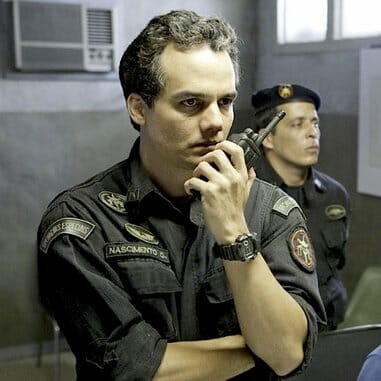Filmmakers using crime and action genres to explore social issues possess an advantage that can also be a pivotal weakness. Kinetic shoot-outs and the plotty maneuvers of mercenary cops can provide an accessible entryway to material that may be ultimately more about institutional corruption and the psychology of policing—but, in its sheer visceral excitement, it can also obscure those very points.
Nonetheless, Padilha seems to have taken into account some of the more left-leaning critiques for his follow-up, which expands its focus from the world of the Rio police to their political masters. We follow the original film’s compelling narrator-protagonist, BOPE Captain Nascimento (Wagner Moura), as he is promoted to a government position and gradually realizes the full extent of the country’s institutional corruption—suggesting that a few tough-on-crime, Dirty Harry-style cops are clearly not going to solve problems this systemic and entrenched. Like The Wire TV series, The Enemy Within traces an intricate web of relationships between corrupt cops and self-serving politicians; however, unlike The Wire, it only has two hours within which to do this. As a result, dense first-person narration, archetypal central characters and thinly drawn supporting ones become par for the course. Unfortunately, in much the same way as the original film’s lurid cop violence (which features here too, albeit less prominently), this set of standard scriptwriting tropes muddies the film’s very relevant and cogent critique.
In the first film, Nascimento functions as a classic unreliable narrator. He engages us with his imperviousness to corruption and moral doubts about his own work before revealing the capacity, and appetite, for coercion and torture (and worse) that his military training has embedded in him. In the sequel, this sequence is reversed, with the now office-bound Nascimento becoming increasingly more critical and enlightened as the film progresses. Rather than a drug dealer or corrupt cop, Nascimento’s key antagonist at the film’s outset is Diogo Fraga (Irandhir Santos), a human rights activist and aspiring politician who staunchly opposes the police’s violent tactics and the broken social and justice systems that rationalize them. In a narrative dovetail that is way too neat, Fraga is also married to Nascimento’s ex-wife and playing stepfather to his son. It’s clear early on that this is an ideological opposition that the film will try to reconcile sooner or later, and that some kind of familial reconnection will play a part in it.
But what’s striking is the way that this opposition is weighted. Apart from the obvious advantage Nascimento has in being the film’s narrator, the film’s casting also sways us further to his point of view. As Nascimento, Moura has an intense charisma, a strange mixture of boyishness and world-weary heaviness. As Fraga, Santos is wiry, righteous and irritating, and there are insinuations of opportunism behind his character’s moralizing. (Early on in the film, his condemnation of a BOPE raid that saves his life serves as a springboard for his political career.) Fraga is revealed to be right about the system’s inherent criminality, but this analysis only really takes on weight through Nascimento’s eyes. The policeman’s macho resourcefulness is also shown to be far more up to the task of combating the worst purveyors of this corruption.
The problem here is that, in allowing Nascimento to give voice to the film’s own critique—to be an ultimately reliable narrator, that is—Padilha leaves some of our hero’s own authoritarian tendencies unquestioned. While Nascimento is forced to rethink many of his assumptions, his own warrior mentality (“to people like me, war is medicine”) does not come under much scrutiny, and the film’s proclivity for violent surprises almost seems to argue for its necessity. He is, from the outset, a “good cop”—smart, efficient, effective and apparently incorruptible—and his narration frequently differentiates between honest and dishonest members of the force. Such distinctions imply that there is an ideal of policing that good cops attempt to uphold. However, if the system that police are paid to protect is itself an embodiment of corruption, rather than a good idea gone bad (and even Nascimento seems to think this by the end), the conclusion could be simple, though perhaps not something the police genre is ever going to embrace: the only good cop is one who quits. Padilha should be commended for avoiding easy solutions to complex problems, but the way in which he frames these problems still leaves certain questions, and answers, off the table.
